Top>Education>Enjoying the forest with Environmental Education
 Index
Index

Naokuni Takeda [Profile]
Enjoying the forest with Environmental Education
Naokuni Takeda
Professor of Comparative Endocrinology and Comparative Physiology, Faculty of Commerce, Chuo University
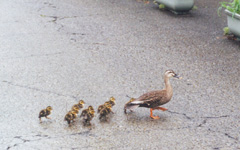
The kanji character for forest is one of those in the mountain classification and represents a mountain covered in trees right up to the summit, and the gods dwell in those forests. Chuo University's Tama Campus, surrounded by green, is situated in the forest of the Tama hills. It is there where I conduct environmental education and nature conservation while enjoying the forest. In the forest is the Forest God, looking over the various inhabitants that live there. The inhabitants at the summit happen to be raccoon dogs and hares so you can feel at ease when strolling around. Also, you can see more than a handful of plants and animals which are endangered species. There are other exciting scenes that can unfold before your eyes such as a spotbill duck taking her ducklings for a walk, a kingfisher readying itself to attack a topmouth gudgeon, baby rabbits fighting playfully at the edge of the forest, or a raccoon dog staring back with its head turned.
The environmental education I have been repeating is not a difficult thing, only it involves learning the names of the forest inhabitants, understanding their place in the biotic environment, and touching them with affection. And also, if it is deemed necessary, nurturing and propagation support. In other words, it is not just protecting nature and having a love for living things, but because I believe we can maintain biological diversity and coexist with living things, and furthermore because it can become practical education related to preservation of ecosystems.
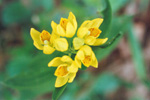
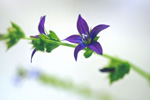
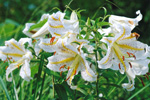
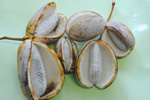
1. Paying homage to Konjin God
When entering a forest, it is courtesy to first pay homage to the god of the forest. At our university we have continued the worshipping of the local deity from the ruins of Konjin Temple in the surrounding trees. Peaches and loquats grow on campus, as well as chestnuts and chocolate vines adding color to the seasons. We offer these to the local god every season and pray for safe walks and surveys in the forest. There are times where I also chant sutras and Shinto prayers. In the forest you can also see the god of the mountain and god of water, the natural features of Japan, which are just sacred straw festoons attached to rocks, showing a sense of respect toward nature: putting beyond doubt that the forest is living.
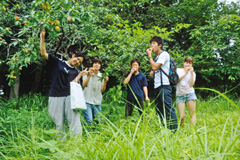
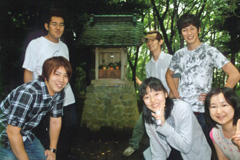
2. Raising Tokyo salamanders
By gathering and raising natural living things we have the perfect opportunity to learn directly about their individual characteristics and habits etc. The salamander, Hynobius nebulosus tokyoensis, is no exception. Tama Campus is blessed with springs and in one is Salamander Valley. When the small pond, where eggs were laid the previous year, is cleaned out in mid- March, it soon fills up with spring water, and the salamanders, that have been waiting for the right time, appear to lay their eggs. Every year, several clusters of eggs are taken away, and seminar students look after them in full participation raising, until the salamanders have metamorphosed to a stage where they can live independently. Meanwhile at the small pond in the forest, we will sometimes check on the salamanders there, bringing bloodworms to help sustain their lack of protein. Usually, around the time they reach the stage where gills regress, the larvae are split up and released in several batches. In this area tree-planting has been taking place from a few years back and created a suitable habitat in which an estimated 70 Tokyo salamanders lurk. But predatory snakes also appear making it a harsh environment with many difficulties.
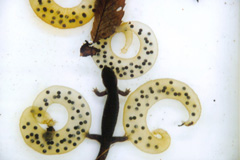
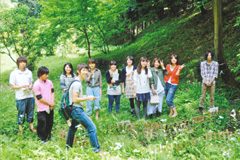
3. Enjoying the flight of Luciola cruciata fireflies
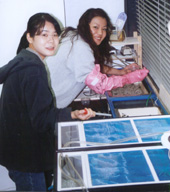
Adding poetic charm to summer, the sight of fireflies flitting around is something I can enjoy over and over. This land used to be rice fields where L.cruciata fireflies are said to have flown about. After that, from the creation of waterways for fireflies, in the form of supplementing spontaneous generation, we have been able to breed L.cruciata fireflies. Through my experience in breeding L.lateralis fireflies I was called in for consultation, and ever since have been in charge of artificial breeding with seminar students. The seminar students in charge of breeding all have a strong attachment to fireflies and even during their spring, summer and winter breaks, concentrate on the breeding without complaint. In that environment, Keiko Sueda won the Dean Award for her graduation thesis, Research Relating to Artificial Breeding of Luciola cruciata, in turn greatly stimulating the other seminar students.
By the way, fireflies do not hatch within a year and it is normal to take two years. Because of that we have to be serious in gathering marsh snails and breeding, and although the time taking for work is doubled, the seminar students set a goal of hatching the fireflies and have them take flight, and have continued in earnest to look after the simple larvae. As a result, in a good year more than 80 fireflies have been hatched. Also, a target has been set of about 20-30 adults a year to be released in the firefly waterway. It may be a result of these efforts, but recently, the steady proliferation of L.cruciata, even in the outdoor waterways, has left me delighted.
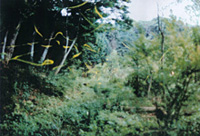
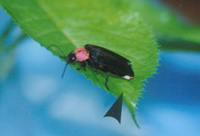
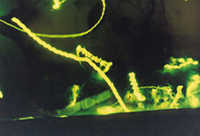
4. Protecting Rana ornativentris frogs which are being overrun by housing
Using my first encounter with frog, R. ornativentris, spawning at the horse-riding club's pond in the early spring of my first year here as a motive, I undertook practical training in frog metamorphosis. Under these circumstances, the R. ornativentris frogs which inhabited the area around the horse-riding club, had to relocate from the pond they had used for spawning as it was now being used for club activities. As there was no place in the university to take the place of the pond, I built a makeshift puddle that year, put organisms from the pond into it and the raised tadpoles. Last autumn, a suitable biotope (small pond) was built in a corner of Sakura-hiroba. From trial digging to completion, this was the result of the youthful strength of the male seminar students.
This spring, freshly lain egg clusters were put in the pond and we could confirm the hatched tadpoles coming onto land. In the autumn, concerned with their growth and living conditions after that, I could confirm a large number of infant R. ornativentris frogs, exceeding expectations, as well as imago-sized frogs, living in the zone surrounding the biotope. This indicated that the R. ornativentris frog rescue project was a success, and the seminar students who put everything into constructing the biotope were immediately overcome with emotion and ecstasy. Although we are still faced with issues until spawning, I want the seminar students to feel pleased with their success in the first step toward protecting the frogs through their own efforts.
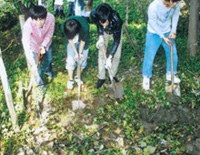
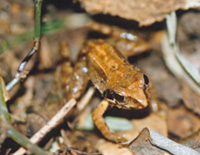
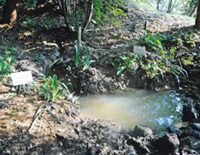
5. Environmental destruction has also taken place ~ Don't make the same mistakes again ~
In saying I enjoy the forest it hasn't been limited to positive experiences. On some occasions there have been appalling situations. In 2005, when artificial turf was put down on the soccer field upstream from the campus' only spring water firefly waterway, poisonous chemicals from the 100 tons of rubber chips resulted in the waterway becoming a dark milky color, inflicting devastating damage on the life inhabiting there, including surrounding areas. Just like the land in Rachel Carson's Silent Spring, I will never forget the unbelievable scenes that were unfolding before my very eyes.
Following that, through measures of continuously pumping spring water and tap water through the waterway, after four years, it has finally showed signs of recovery of late. Landowner has succeeded in releasing eight barbell loaches, Lefua costata echigonia, into the waterway, and now fry a few centimeters in length can be seen all over the place. It pleases me to see the rich ecosystems gradually returning.
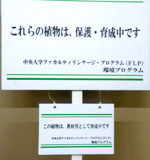
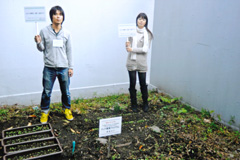
In the ways I have stated above we have been able to enjoy the blessings of the forest, become intimate with the inhabitants of the forest, and deal with the various messages sent to us from those inhabitants. Even if seasonal flowers become sparse, or when footprints are left in the snow, each time the forest presents us with adequate information. Even for my lectures, I always put a few types of seasonal flowers in my satchel, and sometimes even throw in a glowing firefly, and introduce the living creatures of the campus. From now on, I want us to continue not only enjoying the irreplaceable natural heritage of the campus, but we must also continue to protect it.
Finally, Kamo-no-Chomei, who lived a secluded life in Mt. Hino, says it all when he wrote in "Ho-jo-ki (Essays in Idleness)", If there is no fearsome mountain, there will be no prosperity in the mountain to enjoy, and ties it to, Much more, this should not be limited to people who are profound thinkers yet have no deep knowledge.
Click here for the culture program Corridor of Knowledge (Unusual occurrences in conch reproduction and environmental issues, Episode 37), edited by the author![]()
Click here for the culture program Corridor of Knowledge (Reading into evolution through wood lice, Episode 56), edited by the author![]()
- Naokuni Takeda
Professor of Comparative Endocrinology and Comparative Physiology, Faculty of Commerce, Chuo University - Born in Yamagata City in 1945. Left the Graduate School of Science in 1972 after obtaining his doctorate. Later, he became associate professor at the Faculty of Science, Toho University and conducted research as head of research of the biotechnology department at the Cosmo Research Institute, and the RIKEN Brain Science Institute before taking up his current position in 2002. Majors in comparative endocrinology and comparative physiology. Doctor of Agriculture.
- Major coauthored titles: The Biology of Terrestrial Isopods (Academic Press) 1984, Atlas of Endocrine Organs (Springer-Verlag) 1992, Progress in HPLC-HPCE (VSP Inter. Sci. Pub.) 1997, Progress in Developmental Endocrinology (John-Wiley &Sons) 2000.
- Research Activities as a Member of Research Fellowship for Young Scientists (DC1), Japan Society for the Promotion of Science (JSPS) Shuma Tsurumi
- Important Factors for Innovation in Payment Services Nobuhiko Sugiura
- Beyond the Concepts of Fellow Citizens and Foreigners— To Achieve SDGs Goal 10 “Reduce Inequality Within and Among Countries” Rika Lee
- Diary of Struggles in Cambodia Fumie Fukuoka
- How Can We Measure Learning Ability?
—Analysis of a Competency Self-Assessment Questionnaire— Yu Saito / Yoko Neha - The Making of the Movie Kirakira Megane








